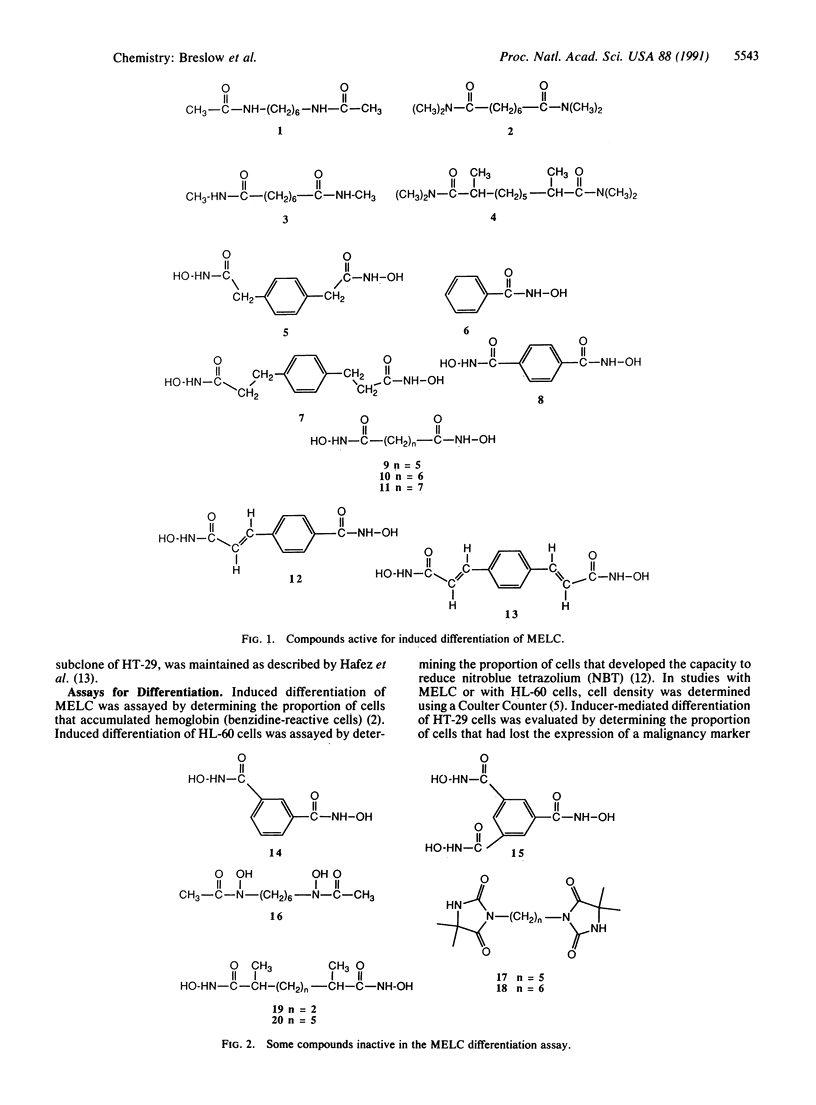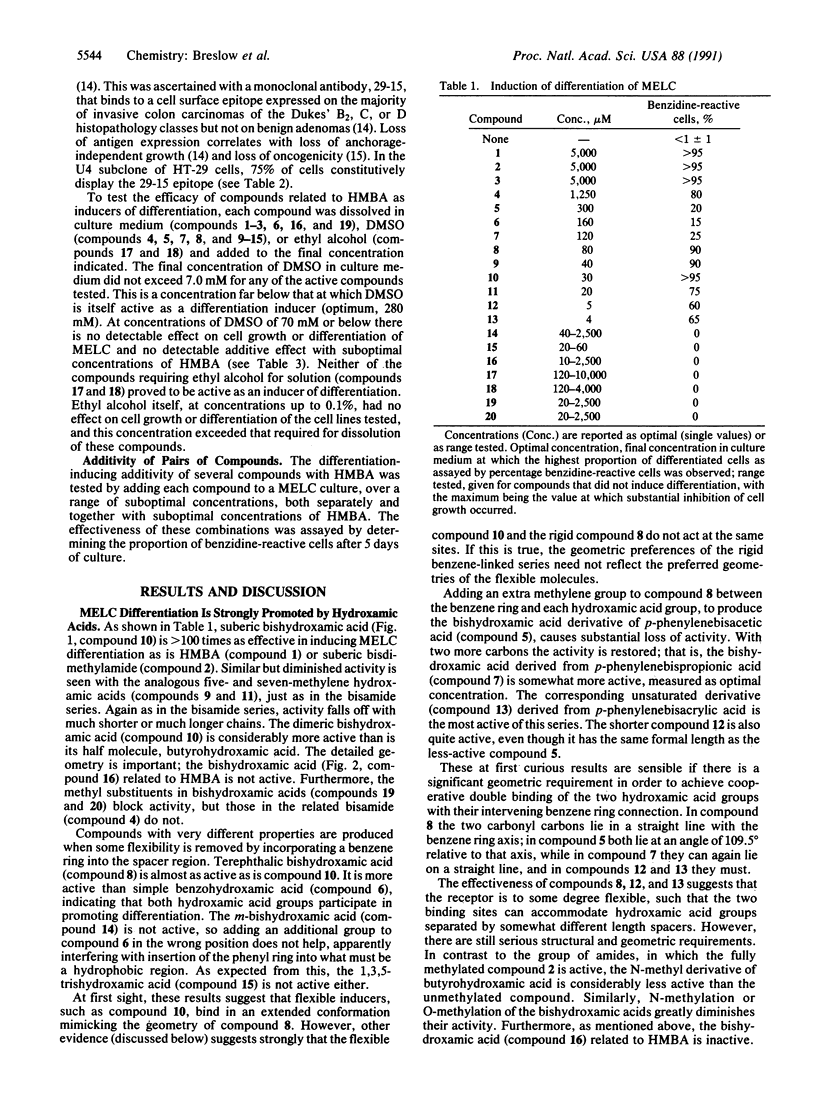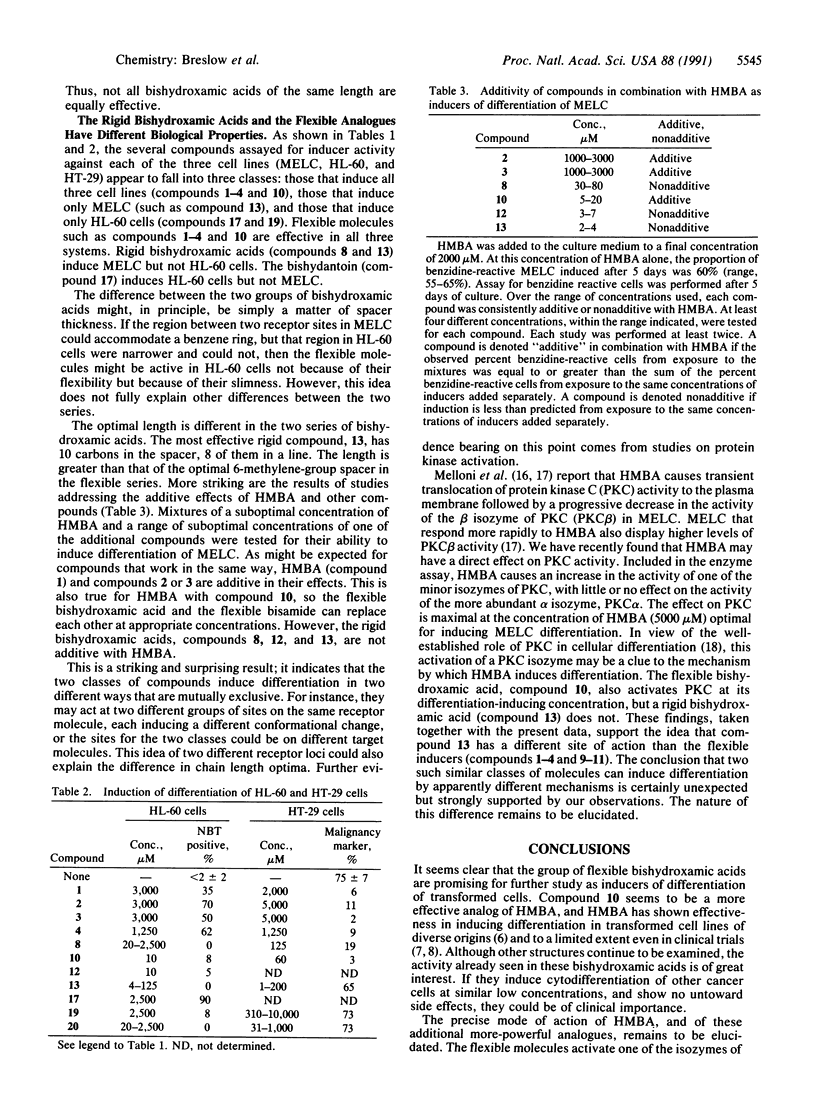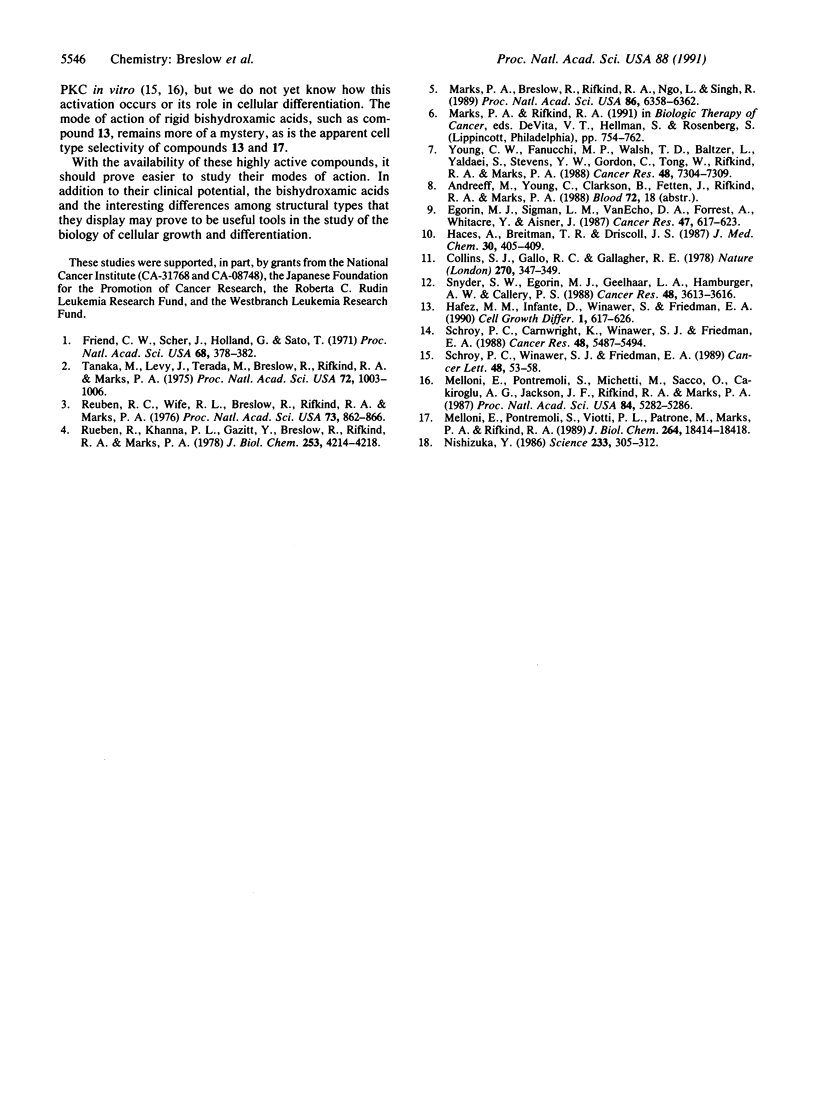Abstract
Bishydroxamic acids are effective inducers of differentiation in murine erythroleukemia cells. Flexible analogs of suberic acid bisdimethylamide are approximately 100 times as active as the parent compound or hexamethylenebisacetamide. They also induce differentiation of human promyelocytic leukemia cells (HL-60) and a subclone of human colon carcinoma cells (HT-29-U4). Some rigid bishydroxamic acids with benzene rings in the spacers are even more active toward murine erythroleukemia cells but show curious biological differences. In contrast to the flexible molecules, those with benzene spacers show poor activity toward HL-60 cells; they also have different geometric requirements, and they are not additive with hexamethylenebisacetamide in their effect. It is likely that rigid bishydroxamic acids, with a benzene ring spacer, induce differentiation by a different mechanism in spite of their chemical resemblance to the flexible bisamide and bishydroxamic acid inducers.
Full text
PDF




Selected References
These references are in PubMed. This may not be the complete list of references from this article.
- Collins S. J., Gallo R. C., Gallagher R. E. Continuous growth and differentiation of human myeloid leukaemic cells in suspension culture. Nature. 1977 Nov 24;270(5635):347–349. doi: 10.1038/270347a0. [DOI] [PubMed] [Google Scholar]
- Egorin M. J., Sigman L. M., Van Echo D. A., Forrest A., Whitacre M. Y., Aisner J. Phase I clinical and pharmacokinetic study of hexamethylene bisacetamide (NSC 95580) administered as a five-day continuous infusion. Cancer Res. 1987 Jan 15;47(2):617–623. [PubMed] [Google Scholar]
- Friend C., Scher W., Holland J. G., Sato T. Hemoglobin synthesis in murine virus-induced leukemic cells in vitro: stimulation of erythroid differentiation by dimethyl sulfoxide. Proc Natl Acad Sci U S A. 1971 Feb;68(2):378–382. doi: 10.1073/pnas.68.2.378. [DOI] [PMC free article] [PubMed] [Google Scholar]
- Haces A., Breitman T. R., Driscoll J. S. Chemical differentiating agents. Differentiation of HL-60 cells by hexamethylenebis[acetamide] analogues. J Med Chem. 1987 Feb;30(2):405–409. doi: 10.1021/jm00385a025. [DOI] [PubMed] [Google Scholar]
- Hafez M. M., Infante D., Winawer S., Friedman E. Transforming growth factor beta 1 acts as an autocrine-negative growth regulator in colon enterocytic differentiation but not in goblet cell maturation. Cell Growth Differ. 1990 Dec;1(12):617–626. [PubMed] [Google Scholar]
- Marks P. A., Breslow R., Rifkind R. A., Ngo L., Singh R. Polar/apolar chemical inducers of differentiation of transformed cells: strategies to improve therapeutic potential. Proc Natl Acad Sci U S A. 1989 Aug;86(16):6358–6362. doi: 10.1073/pnas.86.16.6358. [DOI] [PMC free article] [PubMed] [Google Scholar]
- Melloni E., Pontremoli S., Michetti M., Sacco O., Cakiroglu A. G., Jackson J. F., Rifkind R. A., Marks P. A. Protein kinase C activity and hexamethylenebisacetamide-induced erythroleukemia cell differentiation. Proc Natl Acad Sci U S A. 1987 Aug;84(15):5282–5286. doi: 10.1073/pnas.84.15.5282. [DOI] [PMC free article] [PubMed] [Google Scholar]
- Melloni E., Pontremoli S., Viotti P. L., Patrone M., Marks P. A., Rifkind R. A. Differential expression of protein kinase C isozymes and erythroleukemia cell differentiation. J Biol Chem. 1989 Nov 5;264(31):18414–18418. [PubMed] [Google Scholar]
- Nishizuka Y. Studies and perspectives of protein kinase C. Science. 1986 Jul 18;233(4761):305–312. doi: 10.1126/science.3014651. [DOI] [PubMed] [Google Scholar]
- Reuben R. C., Khanna P. L., Gazitt Y., Breslow R., Rifkind R. A., Marks P. A. Inducers of erythroleukemic differentiation. Relationship of structure to activity among planar-polar compounds. J Biol Chem. 1978 Jun 25;253(12):4214–4218. [PubMed] [Google Scholar]
- Reuben R. C., Wife R. L., Breslow R., Rifkind R. A., Marks P. A. A new group of potent inducers of differentiation in murine erythroleukemia cells. Proc Natl Acad Sci U S A. 1976 Mar;73(3):862–866. doi: 10.1073/pnas.73.3.862. [DOI] [PMC free article] [PubMed] [Google Scholar]
- Schroy P. C., 3rd, Carnright K., Winawer S. J., Friedman E. A. Heterogeneous responses of human colon carcinomas to hexamethylene bisacetamide. Cancer Res. 1988 Oct 1;48(19):5487–5494. [PubMed] [Google Scholar]
- Schroy P., Winawer S., Friedman E. Effect on in vivo tumorigenicity of lengthy exposure of human colon cancer cells to the differentiation agent hexamethylene bisacetamide. Cancer Lett. 1989 Nov 15;48(1):53–58. doi: 10.1016/0304-3835(89)90202-4. [DOI] [PubMed] [Google Scholar]
- Snyder S. W., Egorin M. J., Geelhaar L. A., Hamburger A. W., Callery P. S. Induction of differentiation of human promyelocytic leukemia cells (HL60) by metabolites of hexamethylene bisacetamide. Cancer Res. 1988 Jul 1;48(13):3613–3616. [PubMed] [Google Scholar]
- Tanaka M., Levy J., Terada M., Breslow R., Rifkind R. A., Marks P. A. Induction of erythroid differentiation in murine virus infected eythroleukemia cells by highly polar compounds. Proc Natl Acad Sci U S A. 1975 Mar;72(3):1003–1006. doi: 10.1073/pnas.72.3.1003. [DOI] [PMC free article] [PubMed] [Google Scholar]
- Young C. W., Fanucchi M. P., Declan Walsh T., Baltzer L., Yaldaei S., Stevens Y. W., Gordon C., Tong W., Rifkind R. A., Marks P. A. Phase I trial and clinical pharmacological evaluation of hexamethylene bisacetamide administration by ten-day continuous intravenous infusion at twenty-eight-day intervals. Cancer Res. 1988 Dec 15;48(24 Pt 1):7304–7309. [PubMed] [Google Scholar]


